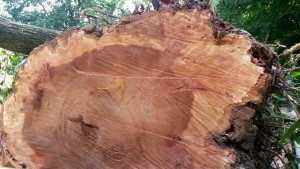Elm Disease: How You Can Help
Posted Tuesday July 21, 2015
We have been reporting on the elm disease situation in Queen’s Park, and you can find out more about the history of the trees in our area here and why we are so blessed to have a thriving elm population in our city.
Here are some important tips from the council Arboralist Team explaining what local residents can do to help maintain and preserve these noble trees.
SPOTTING ELM DISEASE: You can help by using your eyes. You can spot elm disease in the summer months of June, July and August by identifying patches of wilting leaves, autumnal in nature. See photo below of an infected tree. Sometimes, this discolouration is caused by broken branches, probably caused by squirrels. But if in doubt it is best to report such sightings to the local council, who then do their own process to identify possible infection. See link here.
One local resident writes: “I contacted the council via the website regarding a tree near Queen’s Park. Happily the tree was not infected, and I got a phone call from a member of Arboralist Team, who had thoroughly checked out tree. They are sincerely grateful for any help in this area, and clearly follow up all leads.”
AVOIDING ELM LOGS: Do NOT buy elm logs. Always ask wood suppliers is there is any elm wood included, because beetles can easily live within the logs, then come out to play in the summer months. “It’s the easiest way for the beetles to spread and its the hardest one for us to detect. Elm logs used for firewood are our biggest worry.”
PRIVATE ELM TREES: if you have an elm tree in your garden, and have identified a possible infection, the council will examine your tree and if necessary remove it. This service is entirely free of charge. See full details on the council website here.
Click here for more information about elm disease.

